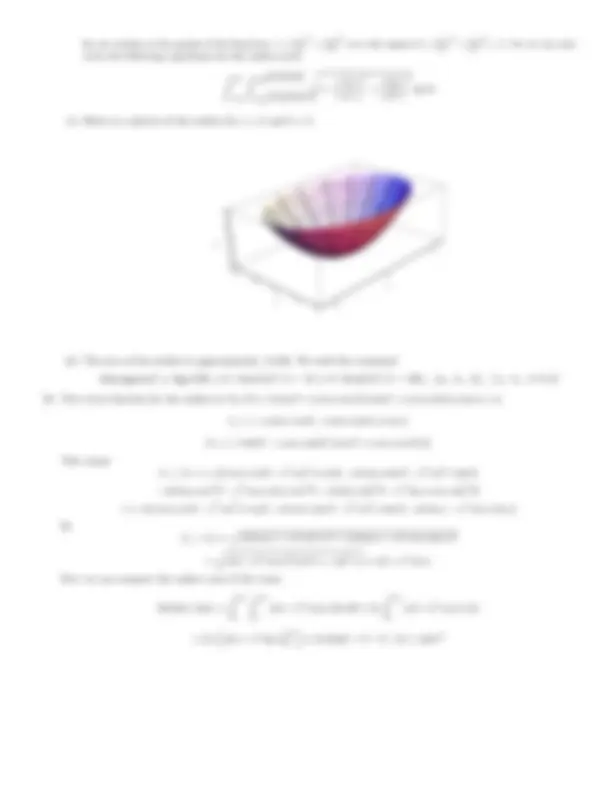



Study with the several resources on Docsity

Earn points by helping other students or get them with a premium plan


Prepare for your exams
Study with the several resources on Docsity

Earn points to download
Earn points by helping other students or get them with a premium plan
Community
Ask the community for help and clear up your study doubts
Discover the best universities in your country according to Docsity users
Free resources
Download our free guides on studying techniques, anxiety management strategies, and thesis advice from Docsity tutors
Solutions to homework problems from sections 12.4 and 12.6 of a university-level mathematics course, math 234, taught in spring 2008. Calculations and integrals related to vector calculus, polar coordinates, and surface integrals.
Typology: Assignments
1 / 2

This page cannot be seen from the preview
Don't miss anything!


R
(x + y) dA =
∫ (^3) π/ 2
π/ 2
1
(r cos θ + r sin θ)r dr dθ =
∫ (^3) π/ 2
π/ 2
(cos θ + sin θ) dθ
2
1
r
2 dr
sin θ − cos θ|
3 π/ 2 π/ 2
r
3
2
1
2
2 meets the plane z = 7 where 7 = 1 + 2x
2
2 =⇒ 2 x
2
2 = 6 =⇒ x
2
2 = 3,
so the domain of integration is the part of the circle about the origin of radius
3 in the first quadrant.
Volume =
∫ (^) π/ 2
0
√ 3
0
(7 − (1 + 2r
2 )) r dr dθ =
π
√ 3
0
(6r − 2 r
3 ) dr =
π
3 r
2 −
r
4
√ 3
0
π
9 π
0
0
e
−r r dr dθ = 2π
0
e
−r r dr
We can do this integral using integration by parts, or we can look it up in the table of integrals:
Volume = 2π
0
e
−r r dr = 2π
(−r − 1)e
−r
R
0
= 2π((−R − 1)e
−R
−R − Re
−R ) ft
3
(b) The average volume per square foot is obtained by dividing the total volume by the area of the circle of radius R:
Average =
2 π(1 − e −R − Re −R )
πR 2
2(1 − e −R − Re −R )
2
ft
3 /ft
2
2
2 , so the surface area is given by:
R
∂f
∂y
∂f
∂z
dy dz =
R
1 + 4y 2
To do this integral over the disk y 2
R
1 + 4y 2
2 π
0
3
0
1 + 4r 2 r dr dθ = 2π
3
0
1 + 4r 2 r dr = 2π
(1 + 4r
2 )
3 / 2
3
0
π
3 / 2 −1)
~ru × ~rv = 〈− 2 bu 2 cos v, − 2 au 2 sin v, abu cos 2 v + abu sin
2 v〉 = 〈− 2 bu 2 cos v, − 2 au 2 sin v, abu〉. So |~ru × ~rv | = √
4 b^2 u^4 cos^2 v + 4a^2 u^4 sin
2 v + a^2 b^2 u^2 = u
4 b^2 u^2 cos^2 v + 4a^2 u^2 sin
2 v + a^2 b^2. This means that the surface area
is given by: ∫ 2 π
0
2
0
u
4 b 2 u 2 cos 2 v + 4a 2 u 2 sin
2 v + a 2 b 2 du dv
(b) Since x a
= u cos v and
y b
= u sin v, we observe that:
x
a
y
b
= u
2 cos
2 v + u
2 sin
2 v = u
2 = z
So our surface is the graph of the function z =
x a
y b
over the region 0 ≤
x a
y b
≤ 4. So we can also
write the following expression for the surface area:
2 a
− 2 a
b
4 −(x^2 /a^2 )
−b
4 −(x^2 /a^2 )
2 x
a 2
2 y
b 2
dy dx
(c) Below is a picture of the surface for a = 2 and b = 3.
0
2
4
X (^) - 5
0
5
Y
0
1
2
3
4
Z
(d) The area of the surface is approximately 115.66. We used the command
NIntegrate[ u Sqrt[36 u^2 (Cos[v])^2 + 16 u^2 (Sin[v])^2 + 36], {u, 0, 2}, {v, 0, 2 Pi}]
~rα = 〈−a sin α cos θ, −a sin α sin θ, a cos α〉
~rθ = 〈−b sin θ − a cos α sin θ, b cos θ + a cos α cos θ, 0 〉
This means
~rα × ~rθ = 〈−ab cos α cos θ − a
2 cos
2 α cos θ, −ab cos α sin θ − a
2 cos
2 α sin θ,
−ab sin α cos
2 θ − a
2 cos α sin α cos
2 θ − ab sin α sin
2 θ − a
2 sin α cos α sin
2 θ〉
= 〈−ab cos α cos θ − a
2 cos
2 α cos θ, −ab cos α sin θ − a
2 cos
2 α sin θ, −ab sin α − a
2 cos α sin α〉
So
|~rα × ~rθ | =
(ab cos α + a^2 cos^2 α)^2 + (ab sin α + a^2 cos α sin α)^2
(ab + a 2 cos α) 2 (cos 2 α + sin
2 α) = ab + a
2 cos α
Now we can compute the surface area of the torus:
Surface Area =
2 π
0
2 π
0
(ab + a
2 cos α) dα dθ = 2π
2 π
0
(ab + a
2 cos α) dα
= 2π
abα + a
2 sin α
2 π
0
= 2π(2abπ + 0 − 0 − 0) = 4abπ
2